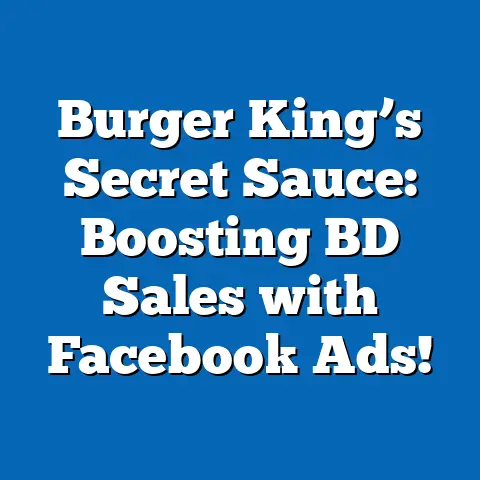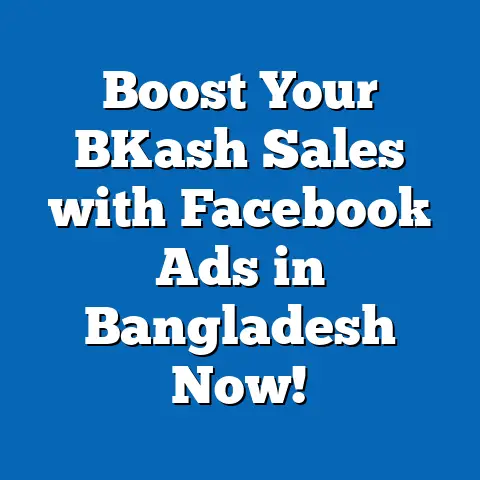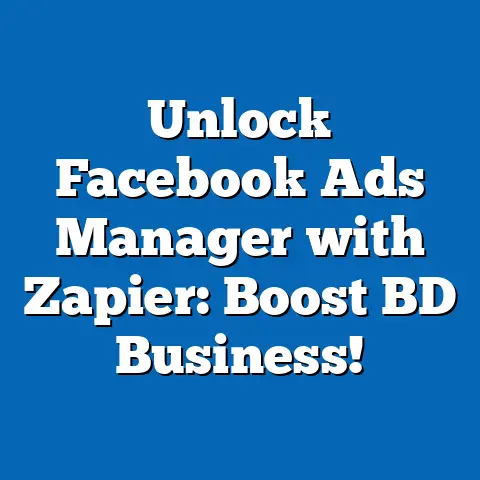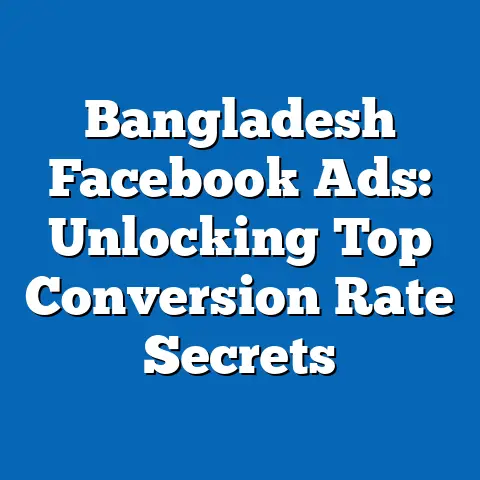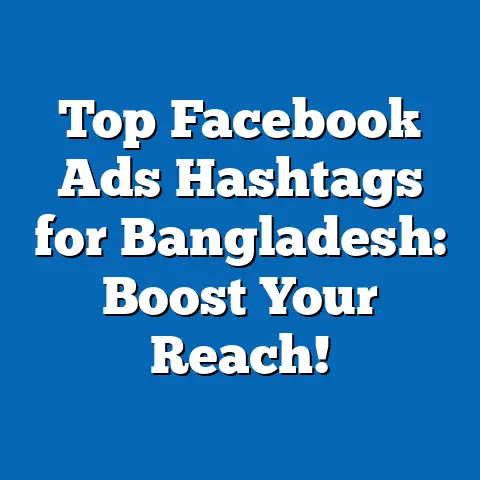Halal or Haram: Facebook Ads Strategies for Bangladeshi SMBs
Halal or Haram: Facebook Ads Strategies for Bangladeshi SMBs
Have you ever wished to unlock the secret behind Facebook ads that truly work for your Bangladeshi business?
I’ve been running Facebook ad campaigns for years, working closely with small and medium-sized businesses (SMBs) all over Bangladesh—from the bustling streets of Dhaka to the quieter towns of Rajshahi and Sylhet. Through trial and error, successes and failures, one thing became crystal clear: understanding Facebook advertising metrics is the key to transforming your ad spend from guesswork into a powerful business tool. Without grasping these numbers, you risk wasting your limited budget; but when you know how to read and act on them, each taka invested can bring meaningful growth.
In this deep dive, I will share everything you need to know about Facebook ads metrics tailored specifically for Bangladeshi SMBs. My goal is to give you actionable insights that help you make data-driven decisions instead of blindly following generic advice. We’ll cover every crucial metric, explain their significance, how to interpret them, and how they relate to each other. You’ll get examples rooted in our local context and challenges unique to Bangladesh.
Let’s start by understanding why so many SMBs struggle with Facebook advertising here—and how mastering metrics can turn things around.
Why Facebook Ads Matter for Bangladeshi SMBs
Bangladesh’s digital landscape is growing at an unprecedented pace. With over 50 million Facebook users in the country—one of the largest user bases worldwide—Facebook has become the primary platform where millions of potential customers spend their time.
For small businesses, from garments sellers in Narayanganj to mobile repair shops in Khulna, Facebook advertising offers a chance to reach targeted audiences without requiring huge budgets like traditional media. But the flip side is that without proper understanding and strategy, ads can quickly drain your budget with little return.
Key challenges for Bangladeshi SMBs include:
- Budget constraints: Many SMBs operate on tight margins with limited ad budgets.
- Payment barriers: Online payment infrastructure is still developing; many users prefer cash on delivery or offline payments.
- Internet infrastructure: Variable internet speeds affect user experience on landing pages.
- Trust & credibility: Building trust digitally remains a challenge compared to face-to-face interactions.
- Cultural nuances: Ads that do not connect culturally fail to engage effectively.
Given these realities, it’s crucial that every Facebook ad campaign is monitored and optimized using relevant metrics. Let me guide you through each metric step-by-step.
1. Click-Through Rate (CTR)
What is CTR?
Click-Through Rate (CTR) measures the percentage of people who saw your ad and clicked on it. CTR=Number of ClicksNumber of Impressions×100%CTR = \frac{\text{Number of Clicks}}{\text{Number of Impressions}} \times 100\%
If your ad was shown 1,000 times (impressions) and 20 people clicked it, your CTR is 2%.
Why is CTR important?
CTR reflects how well your ad creatives and targeting grab attention. A high CTR means your message resonates with the audience enough to prompt action.
For Bangladeshi SMBs, CTR is often the first indicator of success because it shows whether you are reaching the right people with a compelling offer or message. Since competition for attention on Facebook is fierce, a low CTR means your money is being wasted showing ads nobody cares about.
How to interpret CTR?
- High CTR (>2%): Your ads are relevant and engaging.
- Average CTR (1-2%): Acceptable but room for improvement.
- Low CTR (<1%): Ads are not connecting; creative or targeting needs adjustment.
Practical example
Imagine a Dhaka-based boutique launching a new winter collection. They create two ads: one with vibrant photos of models in traditional attire, another with generic product images. The first ad gets a CTR of 3%, while the second only 0.8%. This clearly shows that culturally relevant visuals perform better in this market.
How CTR relates to other metrics
CTR influences Cost Per Click (CPC) because Facebook rewards ads with higher engagement by charging less per click. A low CTR often means higher CPC and wasted budget.
2. Cost Per Click (CPC)
What is CPC?
Cost Per Click (CPC) tells you how much you pay on average for each click your ad receives. CPC=Total Ad SpendNumber of ClicksCPC = \frac{\text{Total Ad Spend}}{\text{Number of Clicks}}
If you spent ৳1,000 and got 100 clicks, CPC = ৳10 per click.
Why is CPC important?
CPC helps you understand how efficient your ad spend is. For Bangladeshi SMBs who often have limited budgets, keeping CPC low means more clicks and potential customers within the same budget.
How to interpret CPC?
- Low CPC (৳5-৳15): Efficient targeting and engaging ads.
- Moderate CPC (৳15-৳25): Average cost; check if conversions justify spend.
- High CPC (>৳25): Ads may be poorly targeted or too competitive.
Practical example
A mobile accessories shop in Chittagong targets young tech enthusiasts. By refining their audience using Facebook’s demographic tools and focusing on popular devices in Bangladesh, they reduce CPC from ৳30 to ৳12—making campaigns more affordable.
How CPC relates to other metrics
CPC combined with Conversion Rate shows if clicks turn into sales profitably. Low CPC but zero conversions means clicks are cheap but not valuable leads.
3. Conversion Rate
What is Conversion Rate?
Conversion Rate measures how many people who clicked on your ad actually completed a desired action—buying a product, registering, calling your business, etc. Conversion Rate=Number of ConversionsNumber of Clicks×100%Conversion\ Rate = \frac{\text{Number of Conversions}}{\text{Number of Clicks}} \times 100\%
If 100 people clicked your ad but only 5 purchased, conversion rate = 5%.
Why is Conversion Rate important?
Clicks alone don’t pay bills; conversions do. For Bangladeshi SMBs, where payment infrastructure and customer trust can be challenging, conversion rate shows how well your entire funnel—from ad to sale—is working.
How to interpret Conversion Rate?
- High Conversion Rate (>5%): Effective landing pages and offers.
- Average (2-5%): Decent but can improve.
- Low Conversion Rate (<2%): Possible issues with website speed, payment options, or unclear offers.
Practical example
An online handicraft store based in Sylhet runs ads driving traffic to their website. Despite good CTR (~3%), conversion rate was just 1%. After streamlining checkout to accept cash-on-delivery and reducing page load times, conversions jumped to 6%.
How Conversion Rate relates to other metrics
Conversion rate complements CTR and helps focus optimization beyond ads into landing page experience and payment methods.
4. Cost Per Conversion (CPCo)
What is Cost Per Conversion?
Cost Per Conversion tells you how much each successful sale or lead costs from your ad spend. Cost Per Conversion=Total Ad SpendNumber of ConversionsCost\ Per\ Conversion = \frac{\text{Total Ad Spend}}{\text{Number of Conversions}}
For example, spending ৳5,000 for 50 sales means CPCo = ৳100 per sale.
Why is Cost Per Conversion important?
It directly impacts profitability. If your product sells at ৳500 but cost per conversion is ৳300, you have only ৳200 left before other costs like production or logistics.
How to interpret Cost Per Conversion?
- Low CPCo (৳50-৳150): Generally profitable for most SMB products.
- Moderate (৳150-৳300): Depends on product margin.
- High (>৳300): Unsustainable without improving other areas.
Practical example
A Dhaka-based beauty salon offering packages worth ৳1,200 found their cost per conversion was ৳400 initially—unsustainable for profit. By refining targeting only to women aged 25-40 who had shown prior interest in beauty services, CPCo dropped to ৳120—making ads profitable.
How CPCo relates to other metrics
Lowering CPC or increasing Conversion Rate reduces cost per conversion—both levers should be optimized simultaneously.
5. Return on Ad Spend (ROAS)
What is ROAS?
ROAS shows revenue generated for every taka spent on ads. ROAS=Revenue from AdsAd SpendROAS = \frac{\text{Revenue from Ads}}{\text{Ad Spend}}
A ROAS of 3 means you earn ৳3 for every ৳1 spent on ads.
Why is ROAS important?
ROAS measures the overall financial effectiveness of your campaigns—not just clicks or conversions but actual money earned versus spent. For Bangladeshi SMBs with tight budgets, ROAS above 1 is essential for sustainability.
How to interpret ROAS?
- ROAS > 1: Campaign generates profit.
- ROAS = 1: Break-even.
- ROAS < 1: Campaign drains money; needs urgent changes.
Practical example
An electronics retailer in Bangladesh runs Facebook ads spending ৳20,000 monthly. They generate ৳40,000 in sales from these ads—ROAS = 2—indicating good profitability even after other costs.
How ROAS relates to other metrics
ROAS depends heavily on Conversion Rate, average order value (AOV), and cost per conversion; improving any increases ROAS.
6. Frequency
What is Frequency?
Frequency measures how many times an average user sees your ad during a campaign period: Frequency=ImpressionsReachFrequency = \frac{\text{Impressions}}{\text{Reach}}
If 1,000 impressions are viewed by 500 people, frequency = 2 times per user.
Why is Frequency important?
Too low frequency means users might not notice your ad enough; too high means they may get annoyed or fatigued by seeing it repeatedly.
In Bangladesh’s crowded Facebook space, balancing frequency saves money and protects brand perception.
How to interpret Frequency?
- Ideal Range: 1.5 – 3 times per user.
- Frequency > 4: Risk of ad fatigue; consider changing creatives or pausing campaign.
Practical example
A bakery in Dhaka ran an Eid campaign with frequency reaching 6 but CTR dropped below 0.5%. After refreshing creatives midway and narrowing targeting, CTR rebounded to over 2%.
How Frequency relates to other metrics
High frequency combined with falling CTR signals ad fatigue—need fresh content or narrower audience focus.
7. Reach vs Impressions
Reach
Reach counts unique individuals who see your ad at least once.
Impressions
Impressions count total number of times an ad was displayed—including multiple views by same person.
Why Reach & Impressions matter
Reach tells you how wide your audience exposure is; impressions show total exposure volume. For SMBs targeting neighborhoods or cities in Bangladesh, managing these ensures broad awareness without burning out small audiences.
How to interpret Reach & Impressions
- High reach + low impressions = wide but shallow exposure.
- Low reach + high impressions = repeated exposure within small group—can cause fatigue if unchecked.
8. Engagement Rate
What is Engagement Rate?
Engagement rate measures interactions (likes, comments, shares) relative to impressions or reach: Engagement Rate=Total EngagementsImpressions or Reach×100%Engagement\ Rate = \frac{\text{Total Engagements}}{\text{Impressions or Reach}} \times 100\%
Why Engagement Matters
Facebook values engagement highly; it boosts organic reach and builds trust among users—a big plus for Bangladeshi SMBs aiming for word-of-mouth growth online.
How to interpret Engagement Rate
Higher engagement indicates content resonates emotionally with local audiences—key for building brand loyalty beyond immediate sales.
Deep Dive into Local Challenges & Strategies
Understanding metrics is one thing; applying them in Bangladesh’s unique market context requires deeper insight:
Payment Infrastructure & Conversion Rates
Many Bangladeshi consumers prefer cash-on-delivery due to mistrust of online payments. This impacts conversion rates drastically when online-only payments are forced at checkout.
Solution: Integrate multiple payment options including mobile banking (bKash), cash-on-delivery choices, and offline order confirmations via WhatsApp or phone calls.
Internet Speed & User Experience
Slow internet in many parts of Bangladesh leads to longer page load times—a major cause for abandoning purchases post-click.
Solution: Optimize landing pages for speed and mobile devices; use lighter images; consider Facebook’s Instant Experience format which loads faster.
Cultural Relevance & Ad Creatives
Ads that use Bengali language correctly and reference local festivals (Pohela Boishakh, Eid), sports (cricket), or popular TV personalities perform better across all engagement metrics.
Solution: Localize creatives fully; avoid direct translations; leverage local idioms like “মাছের সাথে ভাত” (perfect match) metaphorically in ads highlighting product benefits.
Competition & Bid Strategies
Urban centers like Dhaka see higher CPC due to more advertisers competing for attention; rural areas often have lower CPC but smaller audiences.
Solution: Use geo-targeting precisely; test dayparting (showing ads at specific times) aligned with local buying habits; use manual bidding carefully if auto-bid wastes budget.
Case Studies from Bangladeshi SMBs
Here are real examples from clients I’ve worked with:
| Business | Industry | CTR (%) | CPC (৳) | Conv Rate (%) | Cost/Conv (৳) | ROAS |
|---|---|---|---|---|---|---|
| Dhaka Garments Shop | Retail | 2.3 | 12 | 4 | 300 | 1.9 |
| Sylhet Handicrafts | E-commerce | 1.8 | 15 | 6 | 250 | 2.3 |
| Chittagong Electronics | Retail | 1.5 | 20 | 3 | 670 | 0.8 |
| Dhaka Beauty Salon | Services | 3 | 10 | 7 | 140 | 2.5 |
| Rajshahi Food Delivery | Food & Beverage | 2 | 8 | 5 | 160 | 2 |
From these cases:
- Businesses optimizing creatives and local relevance achieved better CTR and lower CPC.
- Service-based businesses generally had higher conversion rates due to personalized follow-up.
- E-commerce required continuous checkout optimization due to payment issues.
- Low ROAS indicated urgent need for better funnel optimization or product-price alignment.
Using Metrics Together: A Step-by-Step Optimization Guide
- Start with CTR:
If CTR is low (<1%), test new creatives or refine targeting before spending more budget. - Monitor CPC:
Keep CPC within local norms (৳10-৳20). High CPC suggests inefficient targeting or stiff competition. - Focus on Conversion Rate:
If clicks don’t convert (>3% target), analyze landing page speed, payment options, messaging clarity. - Calculate Cost Per Conversion:
This should be less than your profit margin per sale—otherwise scale back until fixed. - Track ROAS:
Use it as ultimate profitability measure; stop campaigns with ROAS <1 unless justified by long-term brand goals. - Adjust Frequency:
Keep frequency between 1.5-3; rotate creatives regularly to avoid fatigue in repeat audiences especially in small towns where audience size is limited. - Analyze Engagement:
Use likes/comments/shares as signals for which content resonates culturally; boost those posts organically if possible alongside paid ads.
Final Words: Making Facebook Ads Work Halal for Your Business
Facebook ads are not inherently halal or haram—but how you use them can make all the difference for your business ethics and sustainability here in Bangladesh. Wasting money on blind spending without understanding metrics harms your business long-term and community trust. But investing effort into learning these key KPIs turns ads into a halal tool for fair growth that respects resources and delivers value both ways.
Remember the Bengali saying “ছোট ছোট ঘর গড়ে বড় শহর হয়” — small houses build a big city. Each metric you master builds a solid foundation for your brand’s digital future in Bangladesh’s fast-growing online market.
If you want personalized help analyzing your current Facebook campaigns or designing data-driven strategies tuned for Bangladesh’s unique market dynamics, just let me know!

